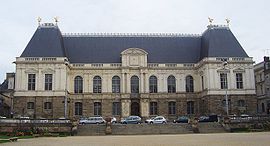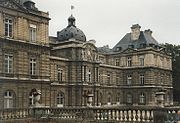
Salomon de Brosse
Encyclopedia

France
The French Republic , The French Republic , The French Republic , (commonly known as France , is a unitary semi-presidential republic in Western Europe with several overseas territories and islands located on other continents and in the Indian, Pacific, and Atlantic oceans. Metropolitan France...
architect, a major influence on François Mansart
François Mansart
François Mansart was a French architect credited with introducing classicism into Baroque architecture of France...
. Salomon was from a prominent Huguenot
Huguenot
The Huguenots were members of the Protestant Reformed Church of France during the 16th and 17th centuries. Since the 17th century, people who formerly would have been called Huguenots have instead simply been called French Protestants, a title suggested by their German co-religionists, the...
family, the grandson through his mother of the designer Jacques I Androuet du Cerceau
Androuet du Cerceau
Androuet du Cerceau was a family of French architects and designers active in the 16th and early 17th century.*Jacques I Androuet du Cerceau *Jean Baptiste Androuet du Cerceau...
and the son of the architect Jean de Brosse. He was established in practice in Paris in 1598 and was promoted to court architect in 1608.
De Brosse greatly influenced the sober and classicizing direction that French Baroque architecture
French Baroque architecture
French Baroque is a form of Baroque architecture that evolved in France during the reigns of Louis XIII , Louis XIV and Louis XV...
was to take, especially in designing his most prominent commission, the Luxembourg Palace
Luxembourg Palace
The Luxembourg Palace in the 6th arrondissement of Paris, north of the Luxembourg Garden , is the seat of the French Senate.The formal Luxembourg Garden presents a 25-hectare green parterre of gravel and lawn populated with statues and provided with large basins of water where children sail model...
, Paris
Paris
Paris is the capital and largest city in France, situated on the river Seine, in northern France, at the heart of the Île-de-France region...
(1615-1624), for Marie de' Medici
Marie de' Medici
Marie de Médicis , Italian Maria de' Medici, was queen consort of France, as the second wife of King Henry IV of France, of the House of Bourbon. She herself was a member of the wealthy and powerful House of Medici...
, whose patronage had been extended to his uncle. Salomon de Brosse simplified the crowded compositions of his Androuet du Cerceau heritage and contemporary practice, ranging the U-shaped block round an entrance court, as Carlo Maderno was doing at Palazzo Barberini
Palazzo Barberini
Palazzo Barberini is a palace in Rome, facing the piazza of the same name in Rione Trevi and is home to the Galleria Nazionale d'Arte Antica.-History:...
, Rome, about the same time. The impetus for the plan is often traced to Palazzo Pitti
Palazzo Pitti
The Palazzo Pitti , in English sometimes called the Pitti Palace, is a vast mainly Renaissance palace in Florence, Italy. It is situated on the south side of the River Arno, a short distance from the Ponte Vecchio...
, Florence, where the Medici
Medici
The House of Medici or Famiglia de' Medici was a political dynasty, banking family and later royal house that first began to gather prominence under Cosimo de' Medici in the Republic of Florence during the late 14th century. The family originated in the Mugello region of the Tuscan countryside,...
queen had spent her youth, but the formal plan of Anet
Anet
Anet is a commune in the Eure-et-Loir department in northern France. It is situated between the rivers Eure and Vègre, northeast of Dreux by rail....
could also be adduced. He clad the building wholly in stone, avoiding the lively contrast of brick and stone that was the more familiar idiom. Though de Brosse was forced to relinquish his post 24 March 1624, construction of the Luxembourg proceeded according to his plan and elevations; extensions made in the nineteenth century have not obscured his external elements.


- the château de Montceaux-en-Brie
- the château of CoulommiersCoulommiersCoulommiers is a commune in the Seine-et-Marne department in the Île-de-France in north-central France.It is also the name of a cheese of the Brie family produced in and around that city.-Twin towns:Coulommiers was twinned with Leighton Buzzard in 1958...
-en-Brie (1612-15), for Catherine GonzagaHouse of GonzagaThe Gonzaga family ruled Mantua in Northern Italy from 1328 to 1708.-History:In 1433, Gianfrancesco I assumed the title of Marquis of Mantua, and in 1530 Federico II received the title of Duke of Mantua. In 1531, the family acquired the Duchy of Monferrato through marriage...
, duchesse de Longueville. - the facade of the Church of Saint-Gervais, Paris (1615-1621)
- the Luxembourg PalaceLuxembourg PalaceThe Luxembourg Palace in the 6th arrondissement of Paris, north of the Luxembourg Garden , is the seat of the French Senate.The formal Luxembourg Garden presents a 25-hectare green parterre of gravel and lawn populated with statues and provided with large basins of water where children sail model...
, ParisParisParis is the capital and largest city in France, situated on the river Seine, in northern France, at the heart of the Île-de-France region...
(1615-1624) - the Parlement de Bretagne RennesRennesRennes is a city in the east of Brittany in northwestern France. Rennes is the capital of the region of Brittany, as well as the Ille-et-Vilaine department.-History:...
(1618) (now a Palace of JusticePalace of JusticePalace of Justice may refer to:Places*Justizpalast *Law Courts of Brussels also known as Justitiepaleis van Brussel in Dutch and Palais de Justice de Bruxelles in French*Palace of Justice *Palace of Justice...
) - the aqueduct of ArcueilArcueilArcueil is a commune in the Val-de-Marne department in the southern suburbs of Paris, France. It is located from the center of Paris.-Name:The name Arcueil was recorded for the first time in 1119 as Arcoloï, and later in the 12th century as Arcoïalum, meaning "place of the arches" , in...
(1624) - the château of BlérancourtBlérancourtBlérancourt is a commune in the department of Aisne in Picardy in northern France.-Population:-Sights:The Château de Blérancourt, an influential design by Salomon de Brosse houses the National Museum of French-American Friendship and Cooperation, , founded by Anne Morgan, daughter of the financier...
(ca 1619)

